Search results for: 7Ps of Marketing
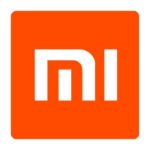
Xiaomi marketing strategy has been traditionally minimalistic due to the cost leadership business strategy pursued by the company. Accordingly, the mobile internet company only engaged in social media marketing, saving on advertising costs and passing this cost advantage to customers in the forms of products with low price tags. However, “Oppo and Vivo have grown in China by using the exact tactics that Xiaomi once avoided. Both companies spend heavily on offline advertisements and celebrity endorsements, plastering billboards on subways and bus stops across China’s second- and third-tier cities.”[1] This has caused a shift in Xiaomi marketing strategy and starting from lately the internet technology company has started to use traditional marketing communications channels as well. Moreover, Xiaomi marketing strategy nowadays also includes product placements and Xiaomi holograms in fiction triller Anon (2018) can be mentioned as an example. As s privately-owned company, Xiaomi does not disclose its annual marketing budget. Xiaomi 7ps of marketing focuses on price element of the marketing mix to a greater extent compared to other elements. Accordingly, the brand’s target customer segment represents price-conscious consumers who want to own the latest smartphones with advanced functions and capabilities for affordable cost. Hunger marketing strategy is one of the integral components of Xiaomi marketing strategy. The electronics and software company appeals to emotional needs of their target customer segment by selling only limited amount of products for a limited duration of time. In other words, the company creates the shortage of supply in purpose, creating a buzz in the market and evoking desire in customers to own a MI brand smartphone. Xiaomi Inc. Report contains a full analysis of Xiaomi marketing strategy. The report illustrates the application of the major analytical strategic frameworks in business studies such as SWOT, PESTEL, Porter’s Five Forces, Value Chain analysis, Ansoff Matrix…

Samsung’s has the largest marketing budget in the competition and this fact partially explains the leadership position of the business in terms of market share. Samsung spent a total of USD10.2 billion (11.5 trillion won) on marketing in 2016 alone. This included USD3.9 billion (4.4 trillion won) toward advertisements, a 15% increase from 2015[1]. Samsung marketing strategy integrates various forms of advertising, events and experiences, public relations, direct marketing and personal selling as discussed further below in more details. The multinational electronics company has 53 global sales bases worldwide. Samsung marketing strategy is based on the following principles: Samsung 7ps of marketing places greater emphasis on product element of the marketing mix, compared to other elements such as process, people and physical evidence. Specifically, with 34 R&D centres worldwide and 53 global production bases, the multinational electronics company attempts to ensure the continuous pipeline of new products with innovative features and capabilities. Samsung segmentation targeting and positioning strategy integrates multi-segment, imitative and anticipatory positioning techniques. Samsung marketing communications strategy, as it is illustrated in figure below, comprises two steps and each step involves a set of separate activities. It has to be noted that legal review as an important element of marketing communication process is present in both steps – production and execution. This is because neglecting legal implications associated with the development and delivery of marketing communication messages can cause considerable damage to the brand image with severe financial implications. Samsung Electronics marketing communication process[2 Samsung Group Report contains a full analysis of Samsung marketing strategy. The report illustrates the application of the major analytical strategic frameworks in business studies such as SWOT, PESTEL, Porter’s Five Forces, Value Chain analysis and McKinsey 7S Model on Samsung. Moreover, the report contains analyses of Samsung leadership, organizational structure and…
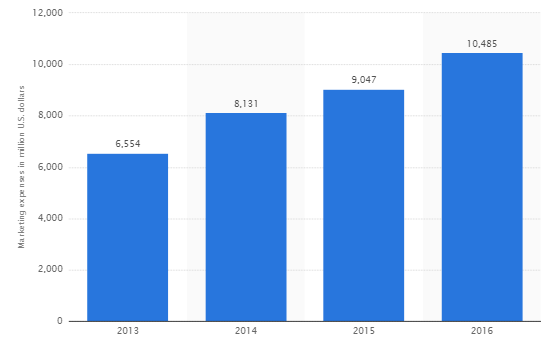
Alphabet (Google) marketing strategy integrates various online and offline marketing techniques. Alphabet’s marketing budgets and efforts mainly focus on main business – Google. It has been noted that “though you’ll never see an ad for the king of the search engines, this query behemoth employs some of the most subtle, yet fantastically impressive marketing strategies out there”[1] Beyond Google, Alphabet Inc. does not invest much resources and efforts to advertise its other projects such as Access, Calico, CapitalG, GV, Nest, Verily, Waymo, and X. This is because most of these projects are only on the stage of research and development and they do not have products and services ready to offer to the market. As it is illustrated in Figure 4 below, total annual marketing spending of the company has been consistently increasing during the past several years. Out of these amounts, for the years ended December 31, 2014, 2015 and 2016, advertising and promotional expenses totalled approximately USD3,004 million, USD3,186 million, and USD3,868 million, respectively[2]. Annual Alphabet Inc. (Google) marketing spending[3] Google marketing strategy is based on the following principles: Within the framework of marketing mix, focusing on product element to a greater extent compared to other elements. The majority of Alphabet products and services are innovative in their nature or they add innovative features to existing products and services. Targeting the broadest customer segment with multiple products and services. The company’s core business, Google offers a wide range of products and services such as Search, Android, Maps, Chrome, YouTube, Google Play, and Gmail that are used by billions of people every day worldwide. Using several elements of marketing communications mix in an integrated manner. Specifically, the internet giant uses sales promotion, events and experiences, public relations and direct marketing tools to company to communicate its marketing message to…
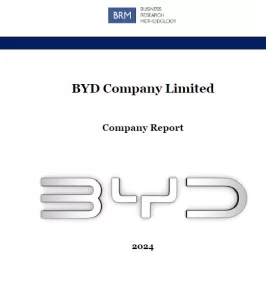
Founded in 1995, BYD Company Limited is a leading technology company that has established itself as an industry leader in electronics, automotives, renewable energy, and rail transit. As a global leader with more than 30 industrial parks across 6 continents, BYD’s zero-emission solutions, focused on energy generation and storage, are expansive and widely applicable. The electric automaker sold 26,864 million units of cars in 2022 , generating operating revenue of RMB 424,061 million, an increase of 96.20% compared to the previous year. The company delivered a record high of 1,788,000 new energy vehicles in 2022, representing a year-on-year growth over 217.6% . The electric vehicle (EV) giant pursues a business strategy of cost leadership fuelled with extensive vertical integration and an accelerated pace of new model development. BYD organizational structure integrates the elements of matrix structure, independent brands, emphasis on R&D and regional variations. Organizational culture of the EV behemoth, on the other hand, is associated with meritocracy, focus on cost-cutting and prioritizing company values. As one of the leading rechargeable battery manufacturers in the global arena BYD possesses certain strengths such as vertical integration and cost advantage, leadership in technological capabilities and economies of scale advantage from massive manufacturing. At the same time, the company has certain weaknesses. These include overdependence on domestic market, too broad range of businesses and dependence on subsidies by Chinese government to sustain cost advantage. BYD Company Limited Report contains the application of the major analytical strategic frameworks in business studies such as SWOT, PESTEL, Porter’s Five Forces, Value Chain analysis, Ansoff Matrix and McKinsey 7S Model on BYD. Moreover, the report contains analyses of BYD’s business strategy, leadership and organizational structure and ecosystem. The report also analysis marketing strategy, ecosystem and discusses the issues of corporate social responsibility. 1. Executive Summary 2. Business…

Company reports, analysis and business research methods since 2011 by John Dudovskiy Save hours of business research by using a library of thoroughly written reports and articles. See Analytical Tools Learn Writing Dissertation Business reports on world’s top companies See All Reports Why Us? All you need for your business research Trusted source of knowledge, honed by years of experience, offering unparalleled depth in business reports, analysis, and research methods since 2011. Your journey to informed decision-making starts here! Competent Researchers A team of seasoned dissertation advisers with practical business management experience. Comprehensive Reports Application of major tools SWOT, PESTEL, Porter’s 5 Forces, Value Chain etc. within a single report. Dissertation Guide Comprehensive guidance from the selection of the research area to the completion of the final draft. Up-to-date Data Regularly updated articles and business reports reflect changes in the macroeconomic environment. Business Analytical Tools SWOT Analysis Ansoff Matrix PESTEL Analysis 7Ps of Marketing Segmentation, Targeting Marketing Communication Mix Porter's Five Forces Analysis Value-Chain Analysis McKinsey 7S Model SWOT Analysis A simple yet powerful framework for assessing a company's competitive position, developing business strategies, and making informed decisions. Strategic analytical tool for analyzing: Strengths Weaknesses Opportunities Threats Learn More Ansoff Matrix A marketing planning model that helps companies to identify and evaluate their growth options and determine its product and market strategy. The model integrates four different strategy options: Market Penetration Product Development Market Development Diversification Learn More PESTEL Analysis Strategic analytical tool for assessing external factors affecting businesses. The PESTEL acronym stands for: Political Economic Social Technological Environmental Legal factors impacting companies Learn More Marketing Mix (7Ps) Comprises elements of the marketing mix. Companies manipulate each element based on their marketing and business strategy: Product Place Price Promotions Process People Physical Evidence Learn More Segmentation, Targeting, Positioning (STP) Consequent…
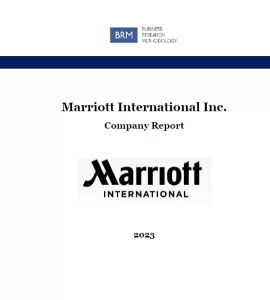
Marriott International is a worldwide operator, franchisor, and licensor of hotel, residential, timeshare, and other lodging properties in 138 countries and territories under 30 brand names. Started as a root beer stand in 1927 in Washington D.C., USA, Marriott has grown into the largest hotel chain in the world. For the full year 2022, gross fee revenues totalled USD 4.1 billion, a significant increase of more than 50 percent compared to 2021. Adjusted EBITDA reached nearly USD 3.9 billion in 2022, up almost 70 percent year over year. Full year adjusted diluted earnings per share (EPS) more than doubled from 2021, totalling USD 6.69. In 2022, Marriott International grew from 7,989 properties (1,479,179 rooms) at year-end 2021 to 8,288 properties (1,525,407 rooms) at year-end 2022, reflecting gross additions of 394 properties (65,376 rooms) and deletions of 94 properties (19,079 rooms), including the impact of the Company’s decision to suspend its operations in Russia. Marriott business strategy integrates pursuing asset-light business model and growing through acquisitions. Moreover, the largest hotel chain in the world focuses on increasing customer segment known as “bleisure travellers”. CEO Anthony Capuano and senior management pursue servant leadership style and the hotel chain has a hybrid organizational structure that combining elements of matrix and functional structures. Marriott International Inc. Report contains the application of the major analytical strategic frameworks in business studies such as SWOT, PESTEL, Porter’s Five Forces, Value Chain analysis, Ansoff Matrix and McKinsey 7S Model on Marriott. Moreover, the report contains analyses of Marriott’s business strategy, leadership and organizational structure and ecosystem. The report also analysis marketing strategy, ecosystem and discusses the issues of corporate social responsibility. 1. Executive Summary 2. Business Strategy 3. Marriott Stock Performance Analysis 4. Leadership 5. Organisational Structure 6. Organizational Culture 7. Marriott and Ansoff Matrix 8. SWOT Analysis…
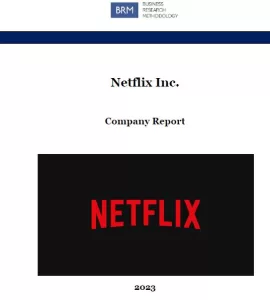
Netflix Inc., the largest streaming service in the world, was incorporated on August 29, 1997 and began operations on April 14, 1998. The entertainment services provider has 231 million paid memberships in over 190 countries. The company employs about 12,800 people in more than 25 countries. Consolidated revenues for the year ended December 31, 2022 increased 6% as compared to the year ended December 31, 2021, due to the 6% growth in average paying memberships and a 1% increase in average monthly revenue per paying membership. Netflix business strategy involves prioritizing revenues maximization over membership growth and increasing investments on original content. Moreover, the streaming service has decided to stay focused on movies, series and documentaries not entering news and live sports segments. The on-demand media provider had change of leadership in 2023 with co-founder Reed Hastings stepping down from the role of co-CEO and Ted Sarandos and Greg Peters becoming new co-CEOs. The largest streaming service in the world has flat organizational culture and its organizational culture has been a subject of case studies in business schools for its unconventionality and effectiveness. Specifically, Netflix organizational culture effectively encourages decision making by employees at all levels and the company has taken information sharing to a whole new level. The popular streaming platform despises rules and communication practices there are candid and direct. Along with its obvious strengths such as first mover advantage, quality original content and global presence, the entertainment services provider has certain weaknesses as well. Namely, Netflix has high level of indebtedness and its business model depends on other companies. Furthermore, the company is over-dependent on North American home market and there is a room for improvement on its customer services. Netflix Inc. Report contains the application of the major analytical strategic frameworks in business studies such as…
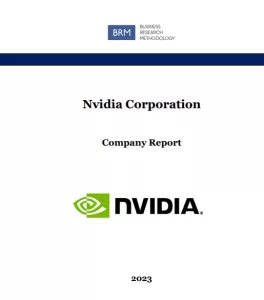
Founded in 1993 by Jensen Huang, Chris Malachowsky and Curtis Priem, Nvidia Corporation is the multinational technology company that aims to solve the world’s visual computing challenges. The GPU maker is the 7th largest company in the world with a market cap of around USD 1 trillion. For fiscal year 2022 the revenue was a record USD 26.91 billion, up 61 percent from USD 16.68 billion a year ago. Gross margins expanded to 64.9 percent, and earnings per share were USD 3.85, up 123 percent from a year ago (Annual Review, 2022) Nvidia business strategy involves benefiting from the first mover advantage, prioritizing performance of products over their costs and pursuing vertical integration. The company’s co-founder and CEO of 30 years Jensen Huang is famous for his charismatic leadership style and his ability to inspire and motivate his team. The multinational technology company has functional and hybrid organizational structure and divides its business practices into various functions such as engineering and product development, supply chain and operations, human resources, finance and accounting and legal and compliance. Nvidia organizational culture integrates the elements of innovation, intellectual honesty, high performance and inclusion and diversity. Within the framework of Ansoff Grow Matrix the company uses all four growth strategies – market penetration, product development, market development and diversification in an integrated manner. The world’s most valuable semiconductor company possesses certain strengths such as global leadership in GPU market, unique position to benefit from the increasing popularity of artificial intelligence (AI) and more than 370 partnerships revolving around self-driving cars. Furthermore, Nvidia possesses advanced R&D capabilities and these allowed the company to reach its current state. At the same time, the software and fables company has serious weaknesses that need to be addressed. At the moment Nvidia depends on a single type of product…
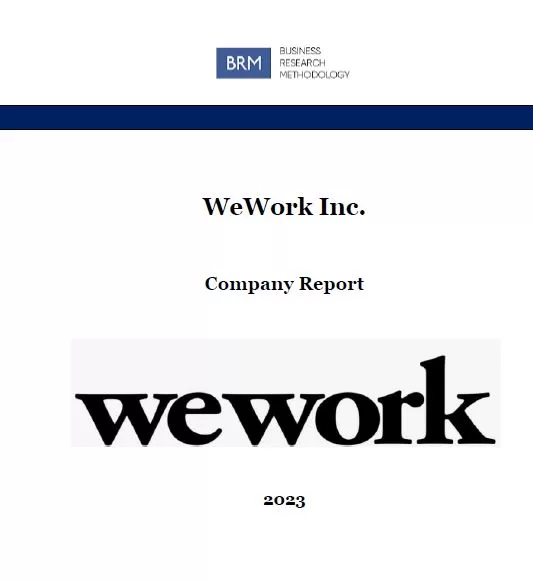
Founded in 2010 in Manhattan USA by Adam Neumann and Miguel McKelvey, WeWork Inc. is a global flexible workspace provider that comprises a network of 756 locations in 38 countries. The co-working giant has approximately 590 thousand physical memberships as of December 2021 (Annual Report, 2021). In the US in 2021 WeWork represented approximately 0.5% of all commercial office space and 63% of Fortune 100 companies are WeWork members WeWork’s mission is to empower tomorrow’s world at work. The workspace provider has a business strategy of digitalizing the real estate business and offering space as a service. The company had severe leadership and ethical challenges under controversial co-founder and the first CEO Adam Neumann, but the current CEO Sandeep Mathrani is bringing discipline and maturity to the leadership. The hierarchical organizational structure of the company has allowed Mathrani to turn around the business to a certain extend via reducing operational costs and focusing on the core business. The co-working and office space operator has considerable strengths such as solid international presence, brand recognition and experience in its niche. At the same time, WeWork has certain serious weaknesses that include the absence of profitability and high level of indebtedness. Moreover, WeWork brand image has been severely damaged due to management and ethical issues under the leadership of Adam Neumann as discussed throughout this report. WeWork Inc. Report contains the application of the major analytical strategic frameworks in business studies such as SWOT, PESTEL, Porter’s Five Forces, Value Chain analysis, Ansoff Matrix and McKinsey 7S Model on WeWork. Moreover, the report contains analyses of WeWork’s business strategy, leadership and organizational structure and ecosystem. The report also analysis marketing strategy, ecosystem and discusses the issues of corporate social responsibility. 1. Executive Summary 2. Business Strategy 3. Leadership 4. Organisational Structure 5. Organizational Culture…
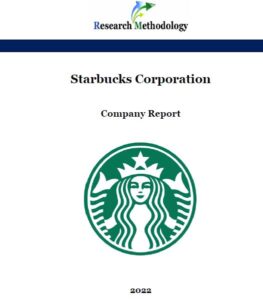
Founded in 1985 by Howard Schultz, Starbucks Corporation (NASDAQ:SBUX) currently operates in more than 34,000 stores in 84 markets according to its mission statement “to inspire and nurture human spirit – one person, one cup and one neighbourhood at a time”. Starbucks Corporation brand portfolio consists of Teavana, Tazo, Seattle’s Best Coffee, Evolution Fresh, La Boulange and Ethos and it sells coffee, tea, other beverages, and a variety of food products. There are two formats of Starbucks stores: company-operated and licensed stores. By the end of fiscal year of 2021, Starbucks had 17,133 (51%) company-operated stores and 16,700 (49%) licensed stores. As of October 2021, Starbucks had approximately 383,000 employees worldwide, including 245,000 employees in the US. The world’s largest coffeehouse chain refers to its employees as partners. Starbucks results for fiscal 2021 demonstrate the overall strength and resilience of the brand. Consolidated revenues increased 24% to USD29.1 billion in fiscal 2021 compared to USD23.5 billion in fiscal 2020, primarily due to business recovery from the COVID-19 pandemic. Also contributing to the increase was USD576 million of incremental revenue attributable to the extra week in fiscal 2021. Starbucks business strategy is associated with providing customers a Starbucks Experience, i.e. a ‘third place’ experience away from work and home, where people can have quality time with friends or alone enjoying quality coffee, beverages and fresh food. Currently, the company is following international business expansion strategy with a particular focus on China and Asia Pacific market segment. Starbucks is an acknowledged leader in the industry in terms of exploiting information technology and technological developments. The company has adapted mobile apps for the promotion of its brand and sales of products earlier than the competition. Starbucks app offers multiple features such as store locator, nutrition-based information and rewards program. Moreover, ‘MyStarbucks Signature’ initiative…
